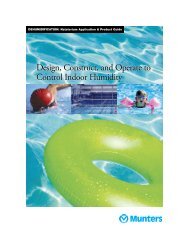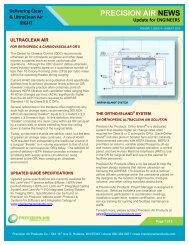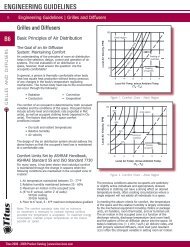Titus 2008 - 2009 Product Catalog | www.titus ... - Texas Air Products
Titus 2008 - 2009 Product Catalog | www.titus ... - Texas Air Products
Titus 2008 - 2009 Product Catalog | www.titus ... - Texas Air Products
Create successful ePaper yourself
Turn your PDF publications into a flip-book with our unique Google optimized e-Paper software.
ENGINEERING GUIDELINES<br />
B<br />
B48<br />
TERMINAL CONTROLS AND ACCESSORIES<br />
Engineering Guidelines | Terminals, Controls and Accessories<br />
Fan Terminal Flow Control (continued)<br />
Voltage Adjustment<br />
Voltage adjustment of fan powered<br />
terminals typically involves the use of<br />
a silicon controlled rectifier (SCR). An<br />
SCR uses a triac to phase proportion<br />
(chop) the electrical sine wave.<br />
In effect, the SCR switches power<br />
off 120 times a second on a 60 Hertz<br />
cycle. This reduces the voltage to the<br />
motor, slowing its speed. In operation,<br />
the SCR responds to the current but<br />
controls voltage. Thus, while an SCR’s<br />
triac may be energized at zero current,<br />
the current sine wave generally<br />
lags the voltage sine wave with an<br />
induction motor. This results in the<br />
idealized voltage sine wave (Figure<br />
74). As the SCR is used to further<br />
reduce fan speed, the true RMS value<br />
of the voltage is reduced.<br />
As voltage to the motor is reduced,<br />
the motor tries to compensate and the<br />
motor’s amp draw rises slightly. The<br />
amperes will continue to increase until<br />
50% of the current sine wave is phase<br />
proportioned. After this point, the amp<br />
draw will decrease. The increased amp<br />
draw is small relative to the reduction<br />
in voltage. As a result, comparing<br />
power consumption of the mechanical<br />
trimming method with the voltage<br />
adjustment method is analogous to<br />
comparing the power consumption<br />
of inlet guide vanes on central air<br />
handlers with speed inverters (Figures<br />
75 and 76).<br />
Fan Speed Control<br />
The rpm of the motor is reduced by<br />
the SCR, lowering the tip speed of the<br />
fan. Since the free area downstream<br />
of the fan is not reduced, the velocity<br />
either meets design conditions or<br />
is lowered if the airflow is reduced<br />
below design for balancing purposes.<br />
There is no increase in sound from air<br />
disturbances.<br />
<strong>Titus</strong> <strong>2008</strong> - <strong>2009</strong> <strong>Product</strong> <strong>Catalog</strong> | <strong>www</strong>.<strong>titus</strong>-hvac.com<br />
0<br />
Figure 74. Idealized Voltage Sine Wave Resulting from an SCR<br />
100%<br />
Watts<br />
0<br />
Figure 75. Watt Reduction Versus cfm<br />
Voltage<br />
Across Motor<br />
50% 100%<br />
<strong>Air</strong> Flow, cfm<br />
A Note on Nameplate Ratings<br />
The amp draw can increase above the nameplate<br />
rating of the motor! The motor’s nameplate<br />
specifies the amp draw for one set of design<br />
conditions. Since the voltage to the motor is<br />
reduced, the nameplate rating is no longer<br />
applicable. If proper care is taken in the design,<br />
specification and selection of the motor by the<br />
terminal manufacturer, the increased amp draw<br />
will pose absolutely no problem in operation or<br />
longevity. Thousands of fan powered terminals<br />
shipped with SCRs over the years serve as<br />
confirmation.<br />
<strong>Titus</strong> accounts for the increased amp draw in the<br />
specification and selection of motors used for<br />
fan powered terminals. As a result, <strong>Titus</strong> specifies<br />
unit fusing adequate to handle the maximum amp<br />
draw possible under all operating conditions. This<br />
differs from the motor nameplate; it is essential<br />
that electric circuit fuses/overcurrent protection<br />
are sized according to the nameplate of the<br />
terminal, not the motor nameplate.








